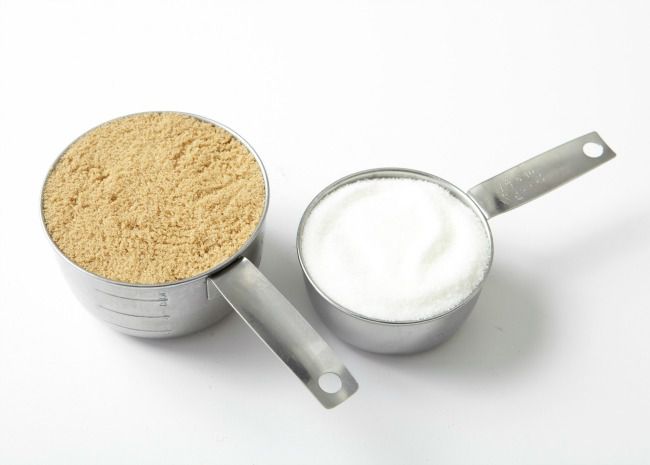Reading food labels can be tricky, especially when all the words sound like they mean the same thing. When you’re grocery shopping and you see labels with “sugar free,” “no sugar added,” and “unsweetened,” it may seem like you can buy any one of those products interchangeably. But each of those labels means something a little different.
Guidelines from the U.S. Food and Drug Administration (FDA) closely regulate the information food companies must include on food packages, but the regulations grow less strict with some nutritional or marketing claims. That’s where descriptions like “lightly sweetened” or “all natural” show up. What do they even mean, and can you rely on the terms to help you make healthful choices for yourself and your family? Not always. We’ll explain.
If you’re concerned about your sugar intake, or if you are newly diagnosed with prediabetes and eager to get a handle on your sugar consumption, it’s smart to familiarize yourself with the many sugar claims and terms company use on their foods. And, remember, just about any food can be enjoyed in moderation to fit into a healthy diet.

America’s Sugar-Rich Diets
The average American consumes about 17 teaspoons of sugar every day. That’s several teaspoons more than what they should be consuming — about 12 to 13 teaspoons in a 2,000-calorie diet, according to the Academy of Nutrition and Dietetics spokesperson Isabel Maples, MEd, RDN.
In 2016, the FDA revised the Nutrition Facts panel on foods in order to list both Total Sugars and Added Sugars. Before this adjustment, it was difficult to know the source of the sugar numbers. For example, a candy bar and a fruit smoothie might have similar total sugar numbers, but one food gets its sugar from candy, caramel, and nougat; the other from fresh fruits, dairy, and vegetables.
Early evidence suggests the updated Nutrition Facts labels are helping people make healthier choices. But the panel, for better or worse, doesn’t always help explain all sugar content claims. So let’s set the record straight on some of this sugar talk.
What Is Sugar Free?
“Sugar free, according to the FDA, means that one serving of food has less than a half a gram of added or naturally occurring sugar. Naturally occurring sugar could be something that’s normally in the food. For instance, it could be fructose in fruit or lactose in milk,” says Maples.
Some other terms you might see that also mean sugar-free are “free of sugar,” “no sugar,” or “zero sugar.” But these foods can still contain artificial sweeteners, like Splenda or NutraSweet, and sugar alcohols, like mannitol or sorbitol. Common sugar-free foods include diet soft drinks and diabetes-friendly candies.
What Is No Sugar Added?
“No sugar added means that when you’re processing or packaging that food, there’s no added sugar added and no ingredient with added sugar is added to that food. You couldn’t add juice or dried fruit or raisins that might be coated in sugar,” says Maples.
No sugar added can also be labeled as “without added sugar” or “no added sugar.” But what can be added to “no sugar added” foods? Anything with naturally occurring sugars, artificial sugars, and sugar alcohols, as long as they weren’t manually added by using sugar or sugar-containing ingredients.
It’s not uncommon to see no sugar added labels on foods like peanut butter, ice cream, and fruit juice.
What Is Reduced Sugar?
“Reduced sugar means that it has at least 25 percent less sugar than the regular food. It could still be high in sugar, though. It still could be something that’s very sweet, so it’s not necessarily saying this is a healthy option,” says Maples. “Were you going to pick the original thing? If you trim 25 percent of the sugar in it and it was something you were going to eat anyway, then maybe it’s a good choice,” says Maples.
What Is Naturally Sweetened?
Naturally sweetened foods, like those sweetened with honey, maple syrup, or agave, do not have an official FDA term. But these might be a good option if you want to use less processed sweeteners. However, it does not mean the food is actually lower in sugar.
“Some people say, ‘I would rather have the maple syrup, the honey, something like that, at least they have some nutrients.’ And they do — it’s not necessarily lots, and it’s probably not enough to really make a difference in nutrition overall, but the thinking is if I’m going to have a sweetener why not have something that’s more natural and less processed,” says Maples.
What Is Lightly Sweetened?
This is a meaningless claim, but food manufacturers may use it to imply their food is healthier than competitors or other versions of their food. Unfortunately, this has no concrete definition and doesn’t tell you anything about the sugar content. You still need to read the label to understand total sugar and added sugar numbers.
What Is Unsweetened?
“Unsweetened means that it doesn’t have any added sugar, low-calorie sweeteners, or sugar alcohols. But it can include naturally occurring sugars like you see in milk and fruit,” says Maples.
Unsweetened is a good option if you’re looking to cut out artificial sugars or reduce the amount of added sugar in your diet. Common unsweetened products include almond milk, iced tea, and applesauce.
The Bottom Line
- Sugar free: Less than 0.5 grams of sugars, both added and natural
- No sugar added: No sugar or sugar-containing ingredient added during processing or packaging, but may still contain some natural and artificial sweeteners
- Reduced sugar: Has 25 percent less sugar then original version of same product
Sugar is not a bad thing, but too much of it can lead to pretty serious health conditions — like diabetes, heart disease, and fatty liver. If you’re looking to cut back on your sugar intake, it doesn’t have to be all or nothing.
“The reality is that all foods can fit into a healthful diet, and that includes sugar. And there’s some really good pluses about sugar. For instance, it makes food taste good, it makes food more tender in baking, it can mask bitterness, it can balance acidity in food. We don’t have to say all of a sudden that any sugar you might have in something is going to be bad because the idea is just to reduce it,” says Maples.
If you’re looking to reduce your sugar intake, Maples suggests two tactics to consider.
First, try “big impact” changes like cutting out high-sugar items, like sugary sodas and sweet coffee drinks, completely. Second, you can trim the amount of sugar in your diet across the board by opting for unsweetened, no sugar added, and reduced sugar products. The best thing to do, according to Maples, is to try a combination of big impact options and trimming your sugar wherever you can.
Related:
- Baking with Sugar and Sugar Substitutes
- 10 Delicious, Filling Snacks for Your No Added Sugar Diet
- Diabetic Recipes




